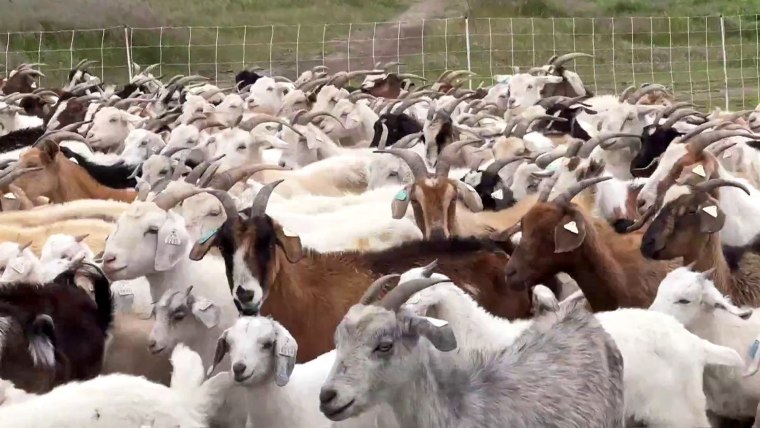Wildfire season in most parts of the western United States could be delayed this summer with heavy snow still covering many mountain ranges, national fire forecasters say. Still, the risk of damaging wildfires continues to trend upward as the climate warms, one factor making it more difficult to predict how the season will shake out.
Forecasters and fire ecology experts said changes to fire behavior make it challenging to predict conditions in the late summer and the early fall. Fire seasons are growing longer. Hotter temperatures zap fuels of their moisture faster. And more people are living near the wilderness — and potentially, in harm’s way.
Jim Wallmann, a meteorologist for the National Interagency Fire Center in Boise, Idaho, said “the likelihood of getting something big early in the year is greatly reduced.”
The NIFC is predicting above-normal fire activity in parts of the Pacific Northwest, including eastern Oregon and central Washington, in July and August. Elsewhere in the West, forecasters are predicting normal or below-normal fire activity for those months.
“With these really wet winters, you think there’s going to be a quieter fire season and they generally start slower,” Wallmann said. “What ends up happening is your fuels still dry out faster than they used to.”
Even if the season starts slowly — it could be the finish that matters most.
Many factors determine the dynamic of a fire season. While it might seem like a wet winter would play a dramatic role, experts say it’s easy to overstate its influence.
“There’s not a strong correlation between winter precipitation and the next season’s fire outlook,” said Craig Clements, the director of the Wildfire Interdisciplinary Research Center at San Jose State University.
Fuel moisture — how wet sticks, logs and grasses are on the landscape — is a better indicator of wildfire risk.
This year, with many areas of California and the Great Basin receiving more than twice as much snow as is typical, researchers expect the snowpack’s melt to keep fuels from drying out quickly. The snowpack will also reduce access to high country wilderness to humans, the most frequent fire-starters in the U.S. Both of these factors should delay the fire season.
“What happens after that? It all depends — it depends how quickly temperatures increase during summer, how long they stay hot and how hot they become,” said Erica Fleishman, a professor at Oregon State University and the director of the Oregon Climate Change Research Institute. “The vegetation can still dry out very quickly.”
In some areas, the wet winter could boost wildfire intensity. For some plants, including nonnative grasses like cheatgrass, abnormal amounts of winter moisture can spur extra growth — creating more fuel, and fire potential, late in the summer.
“Cheatgrass responds well to winter precipitation,” Fleishman said. “It can lead to greater wildfire likelihood and larger wildfires.”
While most western states had wet years, parts of the Pacific Northwest did not. Nearly half of Oregon is in drought, according to the U.S. Drought Monitor.
“In much of the Pacific Northwest, the snowpack was high, but total precipitation was not,” Fleishman said. “The deep snowpack more reflected cold temperatures rather than a lot of precipitation.”
Seasonal outlooks call for high temperatures and fire weather in central Washington and eastern Oregon.
“We’re looking at a little bit above average for temperature across the state for the June through August period and a little drier than normal,” said Vaughn Cork, a fuels analyst with the Washington Department of Natural Resources. “It looks like it will be relatively mild through probably June. And then as our grass starts to cure out in the Columbia Basin, we’ll start to see a few large fires out in the grasslands and once those start hitting the foothills, the timber becomes available.”
An unseasonable heat wave that began this month prompted an early melt and allowed grasses to get an early start on growing.
“That’s something we’re paying attention to,” Wallmann said.
Although the wet winter could slow wildfires in the early summer, climate change is shifting baselines for wildfires across the West.
A Climate Central analysis published Wednesday found a dramatic increase in the number of fire weather days in western states.
The analysis, which evaluated measures of temperature, relative humidity and wind speed, found that some areas in Southern California and New Mexico are seeing an additional two months of fire weather each year than they were a century ago. Some parts of California, Oregon and Washington have twice as much fire weather, the analysis shows.
“Should a fire break out, it’s much more likely to be extreme,” said Kaitlyn Trudeau, a researcher at Climate Central. “It’s an increase in the chance this fire is going to blow up into a much bigger beast than if it wasn’t so hot, dry and windy.”
The area affected by wildland fires doubled from 1984 to 2015, according to research cited in the National Climate Assessment, with climate change playing a large role by drying out fuels.
Other factors — such as more people in wildland areas and a build-up of fuels because of historic fire suppression — are also contributing to the increase in acres burned.
What’s normal — or considered a quiet fire year in the U.S. — is being redefined, said Brian Harvey, a University of Washington forestry scientist and assistant professor.
Federal wildland fire agencies began tracking the number of acres burned nationwide in 1983. Harvey noted that just one fire season saw more than 6 million acres burned from 1983 to 2000.
“We’ve seen 13 years since 2000 where we’ve seen 6 million acres burned,” he said. “It’s a qualitatively different way to think about what is a normal fire year compared to decades ago.”
But the historical record contains evidence of large wildfires and big seasons of smoke. Ecosystems benefit from wildfire. They are adapted to it.
“It’s easy to get in our mind that all fire is going to be bad,” Harvey said. “From an ecological standpoint, fire is a critical agent of resilience in our ecosystems.”







